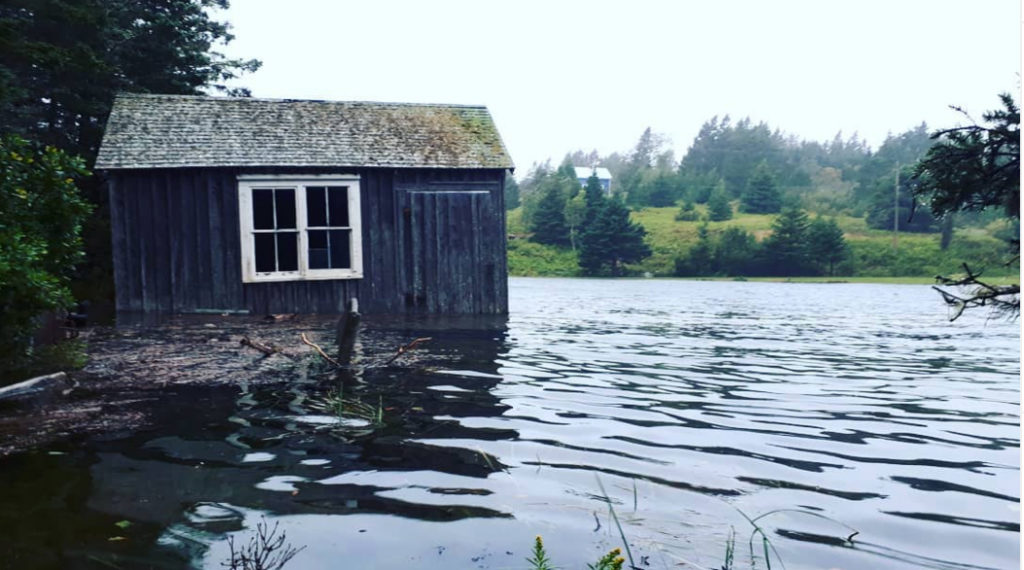Matthew Hughson was working on his museum’s disaster preparedness plan when Hurricane Dorian cut power on Saturday, September 7.
Luckily, as site supervisor for the Fisherman’s Life Museum in Jeddore, Nova Scotia, Hughson had already spent the prior two days in intense preparation for Dorian itself. When the power cut out—and it stayed out for four days—he was just writing up his notes.
“I had spent Thursday and Friday moving collection items and putting them in more central areas of our museum house,” Hughson explained. “Adding extra brackets to the windows, lashing down anything that could be a projectile.” He also secured doors with extra braces and put buckets under the old main-building roof, covering all the furniture with tarpaulins.
Hughson admitted he’d had little sleep over the past week while preparing his museum for, and then helping it recover from, the post-tropical cyclone.
“I spent Saturday, Sunday, Monday and Tuesday sleeping here at the museum,” Hughson adds, “because I knew the wind would be pretty intense, and I knew it would be easier to react to things as they came up rather than trying to get out here later without power and such.”
The Fisherman’s Life Museum is one of 28 sites across the province operating under the umbrella of the Nova Scotia Museum—and as a rural waterfront site composed of repurposed heritage buildings, this one was particularly hard hit.
“A lot of the buildings here at Fisherman’s Life were not meant to be museum buildings initially,” says Hughson. “And the museum has ocean on both sides of it, so it has the potential to get hit quite hard.”
Fisherman’s Life wasn’t the only Nova Scotia Museum site affected by Hurricane Dorian.
“Hurricane-force winds left more than 400,000 customers in Nova Scotia without electricity, including a number of our museums,” confirmed Lynette MacLeod, communications and media relations advisor for the Nova Scotia Museum. (Luckily, the storm surge did not coincide with high tide, or else there might have been more damage.)
The majority of Nova Scotia Museum sites, says MacLeod, were opened as power was restored. But that still meant, according to the museum’s Instagram feed, that several museums remained closed as the post-Dorian week wore on.
On Sunday, September 8, the day after the storm, 9 of the 28 Nova Scotia Museum sites were closed, including the Maritime Museum of the Atlantic and Le Village Historique Acadien de la Nouvelle-Écosse. On Monday, it was 8; Tuesday, 7; Wednesday, 5. Among those still closed on Wednesday, besides Fisherman’s Life, was Ross Farm Museum and the Black Loyalist Heritage Centre. Some sites were still closed Friday, September 13.
Though culture venues in the city of Halifax generally had power restored more quickly, some waterfront arts sites there—like NSCAD University’s Port Campus—were also affected by Dorian.
“Our Port Campus is where the most significant damage occurred,” said NSCAD president Aoife Mac Namara in an emailed statement. She adds: “The damage disrupted HVAC systems and caused structural problems with some kilns.”
NSCAD’s Port Campus is a contemporary concrete, steel and glass structure opened in 2007. NSCAD’s other campuses, the Fountain Campus and the Academy Campus, are heritage buildings further inland and were relatively untouched by the storm.
“Thanks to the diligent efforts of facilities staff and support from the Port Authority and Emergency Services,” Mac Namara adds, “the major repairs were addressed promptly and a detailed assessment of kiln damage has allowed us to move forward on repairing damage to the ceramics infrastructure.”
NSCAD also tried to take advantage of its facilities that were in good condition to extend support to the wider community once it reopened on Tuesday.
“On the first day of the reopening, we hosted a comfort centre for anyone who needed a place to gather, charge their phones, get a hot drink and relax,” says Mac Namara. “We were particularly concerned about students who are new to Halifax, and may not have ever experienced a storm of this magnitude.”
The Khyber Centre for the Arts, an artist-run centre currently located around NSCAD’s Fountain Campus area, was also in good shape after the hurricane—and also wanted to pay that good fortune forward.
“[We’re] really grateful of our own safety, however, have in our hearts the impact on folks in the Bahamas,” wrote Khyber director Hannah Guinan in an email. The Khyber was encouraging membership and supporters to attend a Halifax fundraiser for Bahamas hurricane relief last week.
The Art Gallery of Nova Scotia (AGNS), which is roughly 100 metres inland from the Halifax waterfront, remained closed on Saturday, September 7, as a precaution, and also on Sunday, September 8, due to provincial government requests that people stay off the roads on the day following the storm.
But the AGNS was up and running Monday, “with great visitation by some of the cruise ships in the area,” says Colin Stinson, director of marketing and visitor experience there.
Asked whether the damage sustained by NSCAD’s Port Campus and other waterfront heritage facilities in Nova Scotia had the AGNS re-evaluating its plan to relocate on the Halifax waterfront in coming years, Stinson said “The plan is still underway for a new, modern space” for the gallery on the water.
Yet having been through a storm at his waterfront museum himself this month, and having worked or volunteered in various Nova Scotia museums since 2004, Matthew Hughson believes more than ever that heritage facilities in the province need to be prepared for the shifting events of climate change.
“Because of human-caused realities, the weather has changed a great deal” since many Nova Scotia museums first opened, says Hughson. “The way that site reacts to weather and its effects are also changing as sea levels change.”
For Hughson, it was only being on site this past week or two that really showed him where his museum is most at risk to ever-more-common extreme-weather events. The danger is not only when the power goes out, he notes, but when it comes back on, and how systems react then.
“This [experience] provided a front-row seat to see how things reacted to a sustained power outage,” says Hughson. “It was helpful to see what happened with the power came back on. One of our four alarms immediately started going off…. All of that is hard to determine beforehand,” whether in bigger or smaller heritage facilities, he notes.
Site definitely matters, too, when making museum disaster-plan recommendations. And this may be particularly true in provinces where the heritage that museums are preserving is strongly rural.
“I’ve always really been interested in rural museums, and there are blanket policies that really don’t work for a rural site,” says Hughson. “When you get an email geared to disaster preparedness, it’s often geared to an office worker. You have to really come up with specific plans for the site that you are at.”

 A view of one of the buildings at Fisherman’s Life Museum in Jeddore, Nova Scotia, soon after Hurricane Dorian affected the province. The museum is one of the 28 sites of the Nova Scotia Museum. Photo: Matthew Hughson.
A view of one of the buildings at Fisherman’s Life Museum in Jeddore, Nova Scotia, soon after Hurricane Dorian affected the province. The museum is one of the 28 sites of the Nova Scotia Museum. Photo: Matthew Hughson.




